Chapter: Computer Networks : Network Layer
Multicast Routing Protocols
Multicast Routing Protocols
Unicast, Multicast, and Broadcast:
A message
can be unicast, multicast, or broadcast.
1. Unicasting
In
unicast communication, there is one source and one destination. The
relationship between the source and the destination is one-to-one. In this type
of communication, both the source and destination addresses, in the IP
datagram, are the unicast addresses assigned to the hosts (or host interfaces,
to be more exact).
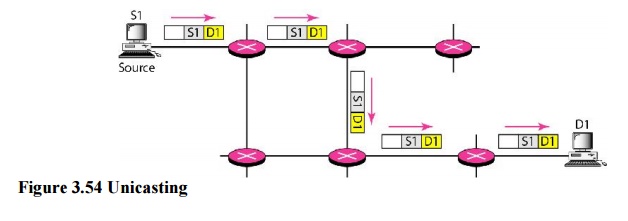
2. Multicasting
In
multicast communication, there is one source and a group of destinations. The
relationship is one-to-many. In this type of communication, the source address
is a unicast address, but the destination address is a group address, which
defines one or more destinations. The group address identifies the members of
the group.
A
multicast packet starts from the source S1 and goes to all destinations that
belong to group G1. In multicasting, when a router receives a packet, it may
forward it through several of its interfaces.

3. Broadcasting
In
broadcast communication, the relationship between the source and the
destination is one-to-all. There is only one source, but all the other hosts
are the destinations. The Internet does not explicitly support broadcasting
because of the huge amount of traffic it would create and because of the
bandwidth it would need. Imagine the traffic generated in the Internet if one
person wanted to send a message to everyone else connected to the Internet.
Multicasting versus Multiple Unicasting
Multicasting
starts with one single packet from the source that is duplicated by the
routers. The destination address in each packet is the same for all duplicates.
Note that only one single copy of the packet travels between any two routers.
In
multiple unicasting, several packets start from the source. If there are five
destinations, for example, the source sends five packets, each with a different
unicast destination address. Note that there may be multiple copies traveling
between two routers.

4. Applications
Multicasting
has many applications today such as access to distributed databases,
information dissemination, teleconferencing, and distance learning.
5. Access to Distributed
Databases
Most of
the large databases today are distributed. That is, the information is stored
in more than one location, usually at the time of production. The user who
needs to access the database does not know the location of the information. A
user's request is multicast to all the database locations, and the location
that has the information responds.
6. Information Dissemination
Businesses
often need to send information to their customers. If the nature of the
information is the same for each customer, it can be multicast. In this way a
business can send one message that can reach many customers. For example, a
software update can be sent to all purchasers of a particular software package.
7. Optimal Routing: Shortest Path
Trees
The
process of optimal interdomain routing eventually results in the finding of the
shortest path tree. The root of the
tree is the source, and the leaves are the potential destinations. The path from
the root to each destination is the shortest path. However, the number of trees
and the formation of the trees in unicast and multicast routing are different.
Unicast Routing: In unicast routing, when a
router receives a packet to forward, it needs to findthe shortest path to the
destination of the packet. The router consults its routing table for that
particular destination. The next-hop entry corresponding to the destination is
the start of the shortest path. The router knows the shortest path for each
destination, which means that the router has a shortest path tree to optimally
reach all destinations. In other words, each line of the routing table is a
shortest path; the whole routing table is a shortest path tree. In unicast
routing, each router needs only one shortest path tree to forward a packet;
however, each router has its own shortest path tree.
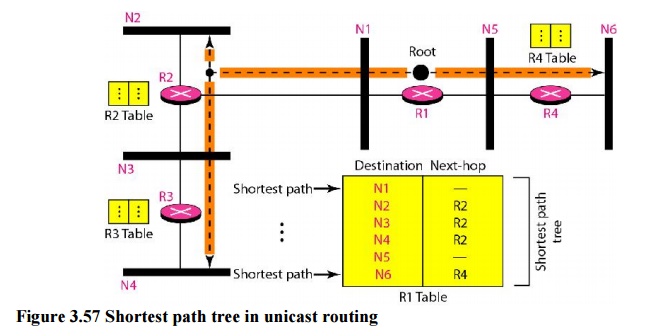
Multicast Routing: When a
router receives a multicast packet, the situation is different fromwhen it
receives a unicast packet. A multicast packet may have destinations in more
than one network. Forwarding of a single packet to members of a group requires
a shortest path tree. If we have n groups, we may need n shortest path trees. We can imagine the complexity of multicast
routing. Two approaches have been used to solve the problem: source-based trees
and group-shared trees.
a. Source-Based Tree: In the
source-based tree approach, each router needs to have one shortestpath tree for
each group. The shortest path tree for a group defines the next hop for each
network that has loyal member(s) for that group. Five groups in the domain: GI,
G2, G3, G4, and G5.
At the
moment G1 has loyal members in four networks, G2 in three, G3 in two, G4 in
two, and G5 in two. We have shown the names of the groups with loyal members on
each network. There is one shortest path tree for each group; therefore there
are five shortest path trees for five groups
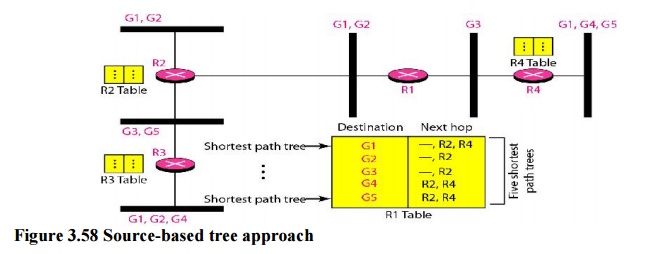
b. Group-Shared Tree:. In the
group-shared tree approach, instead of each router havingmshortest path trees, only one designated router, called the center
core, or rendezvous router, takes the responsibility of distributing multicast
traffic. The core has m shortest path
trees in its routing table. The rest of the routers in the domain have none. If
a router receives a multicast packet, it encapsulates the packet in a unicast
packet and sends it to the core router. The core router removes the multicast
packet from its capsule, and consults its routing table to route the packet.
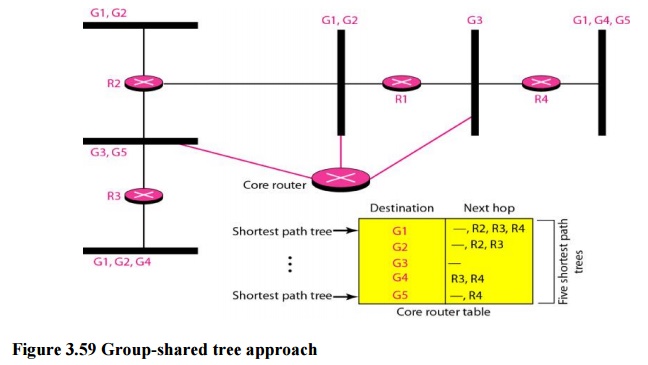
8. Routing Protocols
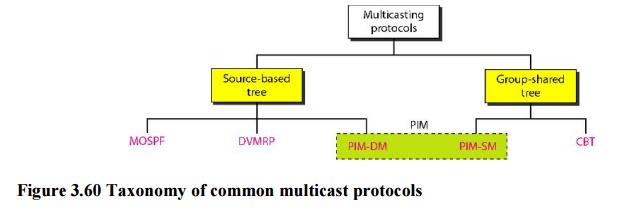
a. Multicast Link State Routing: MOSPF
Multicast
link state routing uses the source-based tree approach. links. For multicast
routing, a node needs to revise the interpretation of state. A node advertises every group which has any loyal member on
the link. Here the meaning of state is "what groups are active on this
link." The information about the group comes from IGMP. Each router
running IGMP solicits the hosts on the link to find out the membership status.
MOSPF Multicast Open Shortest Path First (MOSPF)
protocol is an extension of theOSPF protocol that uses multicast link state
routing to create source-based trees. The protocol requires a new link state
update packet to associate the unicast address of a host with the group address
or addresses the host is sponsoring. This packet is called the group-membership
LSA.
b. Multicast Distance Vector: DVMRP
Multicast Distance Vector Routing Unicast
distance vector routing is very simple; extending itto support multicast
routing is complicated. Multicast routing does not allow a router to send its
routing table to its neighbors. The idea is to create a table from scratch by
using the information from the unicast distance vector tables.
Multicast
distance vector routing uses source-based trees, but the router never actually
makes a routing table. When a router receives a multicast packet, it forwards
the packet as though it is consulting a routing table.
a)
Flooding
b)
Reverse
Path Forwarding (RPF)
c)
Reverse
Path Broadcasting (RPB)
d)
Reverse
Path Multicasting (RPM)
DVMRP The Distance Vector Multicast
Routing Protocol (DVMRP) is animplementation of multicast distance vector
routing. It is a source-based routing protocol, based on RIP.
c. CBT
The
Core-Based Tree (CBT) protocol is a group-shared protocol that uses a core as
the root of the tree. The autonomous system is divided into regions, and a core
(center router or rendezvous router) is chosen for each region.
The
Core-Based Tree (CBT) is a group-shared tree, center-based protocol using one
tree per group. One of the routers in the tree is called the core. A packet is
sent from the source to members of the group following this procedure:
a)
The source, which may or may not be part of the
tree, encapsulates the multicast packet inside a unicast packet with the
unicast destination address of the core and sends it to the core. This part of
delivery is done using a unicast address; the only recipient is the core
router.
b) The core
decapsulates the unicast packet and forwards it to all interested intetfaces.
c)
Each router that receives the multicast packet, in
tum, forwards it to all interested interfaces.
PIM
Protocol Independent Multicast (PIM) is the
name given to two independent multicastrouting protocols: Protocol Independent
Multicast, Dense Mode (PIM-DM) and Protocol Independent Multicast, Sparse Mode
(PIM-SM). Both protocols are unicast protocol-dependent, but the similarity
ends here.
PIM-DM
PIM-DM is
used when there is a possibility that each router is involved in multicasting
(dense mode). In this environment, the use of a protocol that broadcasts the
packet is justified because almost all routers are involved in the process.
PIM-DM is a source-based tree routing protocol that uses RPF and pruning and
grafting strategies for multicasting. Its operation is like that of DVMRP.
PIM-SM
PIM-SM is
used when there is a slight possibility that each router is involved in
multicasting (sparse mode). In this environment, the use of a protocol that
broadcasts the packet is not justified; a protocol such as CBT that uses a
group-shared tree is more appropriate. PIM-SM is used in a sparse multicast
environment such as a WAN. PIM-SM is a group-shared tree routing protocol that
has a rendezvous point (RP) as the source of the tree.
Related Topics